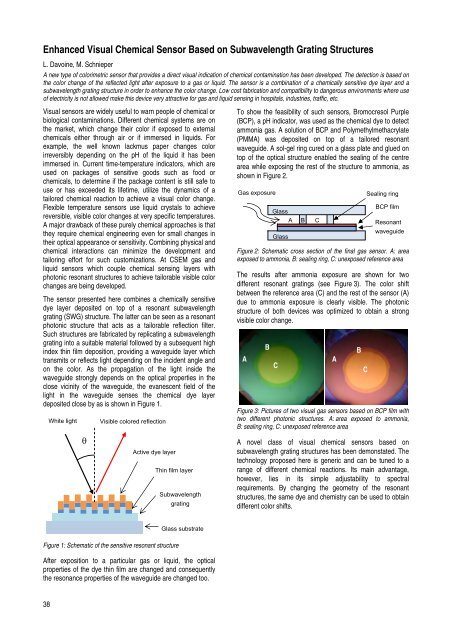CSEM Scientific and Technical Report 2008
CSEM Scientific and Technical Report 2008
CSEM Scientific and Technical Report 2008
Create successful ePaper yourself
Turn your PDF publications into a flip-book with our unique Google optimized e-Paper software.
Enhanced Visual Chemical Sensor Based on Subwavelength Grating Structures<br />
L. Davoine, M. Schnieper<br />
A new type of colorimetric sensor that provides a direct visual indication of chemical contamination has been developed. The detection is based on<br />
the color change of the reflected light after exposure to a gas or liquid. The sensor is a combination of a chemically sensitive dye layer <strong>and</strong> a<br />
subwavelength grating structure in order to enhance the color change. Low cost fabrication <strong>and</strong> compatibility to dangerous environments where use<br />
of electricity is not allowed make this device very attractive for gas <strong>and</strong> liquid sensing in hospitals, industries, traffic, etc.<br />
Visual sensors are widely useful to warn people of chemical or<br />
biological contaminations. Different chemical systems are on<br />
the market, which change their color if exposed to external<br />
chemicals either through air or if immersed in liquids. For<br />
example, the well known lackmus paper changes color<br />
irreversibly depending on the pH of the liquid it has been<br />
immersed in. Current time-temperature indicators, which are<br />
used on packages of sensitive goods such as food or<br />
chemicals, to determine if the package content is still safe to<br />
use or has exceeded its lifetime, utilize the dynamics of a<br />
tailored chemical reaction to achieve a visual color change.<br />
Flexible temperature sensors use liquid crystals to achieve<br />
reversible, visible color changes at very specific temperatures.<br />
A major drawback of these purely chemical approaches is that<br />
they require chemical engineering even for small changes in<br />
their optical appearance or sensitivity. Combining physical <strong>and</strong><br />
chemical interactions can minimize the development <strong>and</strong><br />
tailoring effort for such customizations. At <strong>CSEM</strong> gas <strong>and</strong><br />
liquid sensors which couple chemical sensing layers with<br />
photonic resonant structures to achieve tailorable visible color<br />
changes are being developed.<br />
The sensor presented here combines a chemically sensitive<br />
dye layer deposited on top of a resonant subwavelength<br />
grating (SWG) structure. The latter can be seen as a resonant<br />
photonic structure that acts as a tailorable reflection filter.<br />
Such structures are fabricated by replicating a subwavelength<br />
grating into a suitable material followed by a subsequent high<br />
index thin film deposition, providing a waveguide layer which<br />
transmits or reflects light depending on the incident angle <strong>and</strong><br />
on the color. As the propagation of the light inside the<br />
waveguide strongly depends on the optical properties in the<br />
close vicinity of the waveguide, the evanescent field of the<br />
light in the waveguide senses the chemical dye layer<br />
deposited close by as is shown in Figure 1.<br />
Figure 1: Schematic of the sensitive resonant structure<br />
After exposition to a particular gas or liquid, the optical<br />
properties of the dye thin film are changed <strong>and</strong> consequently<br />
the resonance properties of the waveguide are changed too.<br />
38<br />
White light<br />
θ<br />
Visible colored reflection<br />
Active dye layer<br />
Thin film layer<br />
Subwavelength<br />
grating<br />
Glass substrate<br />
To show the feasibility of such sensors, Bromocresol Purple<br />
(BCP), a pH indicator, was used as the chemical dye to detect<br />
ammonia gas. A solution of BCP <strong>and</strong> Polymethylmethacrylate<br />
(PMMA) was deposited on top of a tailored resonant<br />
waveguide. A sol-gel ring cured on a glass plate <strong>and</strong> glued on<br />
top of the optical structure enabled the sealing of the centre<br />
area while exposing the rest of the structure to ammonia, as<br />
shown in Figure 2.<br />
Gas exposure<br />
Glass<br />
A B C<br />
Glass<br />
Sealing ring<br />
BCP film<br />
Resonant<br />
waveguide<br />
Figure 2: Schematic cross section of the final gas sensor. A: area<br />
exposed to ammonia, B: sealing ring, C: unexposed reference area<br />
The results after ammonia exposure are shown for two<br />
different resonant gratings (see Figure 3). The color shift<br />
between the reference area (C) <strong>and</strong> the rest of the sensor (A)<br />
due to ammonia exposure is clearly visible. The photonic<br />
structure of both devices was optimized to obtain a strong<br />
visible color change.<br />
A<br />
B<br />
C<br />
Figure 3: Pictures of two visual gas sensors based on BCP film with<br />
two different photonic structures. A: area exposed to ammonia,<br />
B: sealing ring, C: unexposed reference area<br />
A novel class of visual chemical sensors based on<br />
subwavelength grating structures has been demonstated. The<br />
technology proposed here is generic <strong>and</strong> can be tuned to a<br />
A<br />
range of different chemical reactions. Its main advantage,<br />
however, lies in its simple adjustability to spectral<br />
requirements. By changing the geometry of the resonant<br />
structures, the same dye <strong>and</strong> chemistry can be used to obtain<br />
different color shifts.<br />
A<br />
B<br />
C








